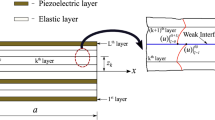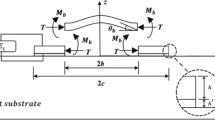Summary
In this paper, we examine the coupled electromechanical behaviour of a piezoceramic actuator bonded to a finite elastic medium under inplane mechanical and electric loading. The purpose of the current work is to study the suitability of using a simple actuator model to simulate the load transfer between actuators and the host medium. The actuator is characterized by an electroelastic line model with the poling direction being perpendicular to its length. The solution of this electromechanically couple problem is provided by solving singular integral equations in terms of an interfacial shear stress and conducting finite element analysis. The results show that the transfer of the actuation energy between the actuator and the host structure can be effectively simulated using the developed theoretical model. Typical examples are provided to show the effects of the geometry, the material combination and anisotropy upon the load transfer. The study is further extended to treat the interfacial debonding between the actuator and the host material.
Similar content being viewed by others
References
Ashley, S.: Smart skis and other adaptive structures. Mech. Engng12, 76–81 (1995).
Gandhi, M. V., Thompson, B. S.: Smart materials and structures. London: Chapman & Hall 1992.
Ha, S. K., Kerlers C. and Chang, F. K.: Finite element analysis of composite structures containing distributed piezoelectric sensors and actuators. AIAA Journal30, 772–780 (1992).
Varadan, V. K., Wu, Z., Bao, Z.-Q., Varadan, V. V.: Light weight robot using piezoelectric motor, sensor and actuator. Adaptive Structures and Material Systems35, 141–148 (1993).
Crawley, E. F., de Luis, J.: Use of piezoelectric actuators as elements of intelligent structures. AIAA Journal25, 1373–1385 (1987).
Im, S., Atluri, S. N.: Effects of a piezo-actuator on a finite deformation beam subjected to general loading. AIAA Journal27, 1801–1807 (1989).
Lin, M. W., Rogers, C. A.: Modeling of the actuation mechanism in a beam structure with induced strain actuators. Proceedings of AIAA/ASCE/ASME/ASC 34th Structures, Structural Dynamics and Materials Conference. AIAA Inc., Washington, DC, La Jolla, CA. VI, 3608–3617 (1993).
Lin, M. W., Rogers, C. A.: Actuation response of a beam structure with induced strain actuators. Adaptive Structures and Material Systems35, 129–139 (1993).
Wang, B.-T., Rogers, C. A.: Laminate plate theory for spatially distributed induced strain actuators. J. Composite Materials25, 433–452 (1991).
Tauchert, T. R.: Piezothermoelastic behaviour of a laminated plate. J. Thermal Stresses15, 25–37 (1992).
Dimitriadis, E. K., Fuller, C. R., Rogers, C. A.: Piezoelectric actuators for distributed noise and vibration excitation of thin plates. J. Vibrat. Acoustics13, 100–107 (1991).
Tzou, H. S., Tseng, C. I.: Distributed vibration control and identification of coupled elastic/piezoelectric systems. Mechanical Systems and Signal Processing5, 215–231 (1991).
Mitchell, J. A., Reddy, J. N.: A study of embedded piezoelectric layers in composite cylinders. ASME J. of Appl. Mech.62, 166–173 (1995).
Banks, H. T., Smith, R. C.: The modeling of piezoceramic patch interactions with shells, plates, and beams. Quart. Appl. MathematicsLIII, 353–381 (1995).
Han, J.-H. and Lee, I.: Analysis of composite plates with piezoelectric actuators for vibration control using layerwise displacement theory. CompositesB29, 519–672 (1998).
Tzou, H. S. and Ye, R.: Piezothermoelasticity and precision control of piezoelectric systems: theory and finite element analysis. J. Vibrat. Acoustics116, 489–495 (1994).
Lim, Y.-H., Gopinathan, S. V., Varadan, V. V., Varadan, V. K.: Finite element simulation of smart structures using an optimal output feedback controller for vibration and noise control. Smart Materials and Structures8, 324–337 (1999).
Wang, X. D., Meguid, S. A.: Modelling and analysis of a thin piezoelectric actuator. Int. J. Solids Struct.37, 3231–3251 (2000).
Muskhelishvili, N. I.: Some basic problems of the mathematical, Gronnigen: Noordhoff 1953.
Park S. B., Sun C. T.: Crack extension in piezoelectric materials. SPIE2189, 357–368 (1994).
Author information
Authors and Affiliations
Rights and permissions
About this article
Cite this article
Wang, X.D., Huang, G.L. Modelling and analysis of piezoelectric actuators in anisotropic structures. Acta Mechanica 155, 45–63 (2002). https://doi.org/10.1007/BF01170839
Received:
Revised:
Issue Date:
DOI: https://doi.org/10.1007/BF01170839




